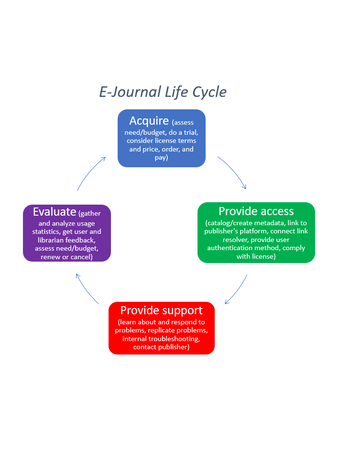
The Life and Times of an E-journal
Electronic resources are increasingly a preferred method of accessing content. Who can argue with the convenience of being able to access research materials wherever you happen to be? But have you ever wondered how electronic resources come to be available for use? Once available, how are they maintained, and what happens when something goes wrong? All of these questions and more occupy us in Collection Management, where we work to ensure we have the resources you need and make sure those resources are accessible wherever and whenever. It’s time to go behind the scenes!
One major type of electronic content the SU Libraries purchase is electronic journal subscriptions. All purchasing decisions come from either a course evaluation of needs, a faculty/student request or librarian decision. Journals are purchased or renewed once a year as they fall under a subscription model, and, as with most subscription models, costs are always increasing. One interesting thing to note is that electronic resources often cost significantly more than their print counterparts due to the convenience of multiple users being able to view the content at once and the ability to view the content without coming to the library.
Once purchase decisions have been made, the next challenge is to make sure that you, the user, can easily locate the journals/articles. From your end, you type a search query into our search box, what we call a discovery layer. Behind the scenes, on our end, we have made sure that each resource we have is cataloged using metadata. Put simply, metadata is information about a resource such as title, edition, keywords and subjects. Conceptually, to catalog an item is to add it to a list of things we own, and the metadata tells the discovery layer all about the item so it can be retrieved later in a variety of different ways.
Another way we ensure you can access the resource is through the use of a link resolver. The link resolver works with the discovery layer to read our title metadata and link you to the material directly. You know and love it as the “Find it” button! Now, you may be wondering where exactly the link resolver is pointing toward. A fascinating intricacy about electronic resources is the multiple hosting platforms that we interface with. The publishers maintain content on their own research platforms and provide SU’s users with access via license to their site to whatever we purchase. We tell the link resolver what we own, it points you to the resource using the link we have from the publisher, and, if you are off campus, we authenticate you by using what’s called a proxy server. You sign in and this tells the publisher’s platform that you are “coming from SU” even when you are at home.
Of course, sometimes things go wrong, and when they do, it is important for us to investigate, diagnose and correct the issue as quickly as possible. For journals, this might manifest in the form of a broken link to an individual article or perhaps an entire platform isn’t allowing access to content. There are mechanisms within both the discovery layer and the link resolver to report access issues, but we also respond to problems via email or in-person notification. When we hear about a problem, Collection Management becomes a detective in order to replicate the issue and get the problem resolved as efficiently as possible. The issue may be resolved internally via troubleshooting, or it may need to be sent to the publisher for further investigation.
Electronic journals may not meet our users’ needs forever and, since they continue to have an annual cost, it is imperative that we purchase the journals that our users need access to and replace those journals that are no longer meeting our needs. Each year during the renewals process, we take the statistics we have collected about how each journal has been used and weigh that information once more against course needs and feedback from users. Annual evaluation is the best way to make sure that our collection grows in the right way for our users.
Electronic resources are convenient, engaging and accessible from anywhere, which make them an integral part of the collection for now and the future. Access is, and should be, easy, but it still takes a team of dedicated people to make sure that the right resources are there when you need them. Thanks for coming on this brief tour behind the scenes into one aspect of the collection.
